
In the daily hubbub of current “crises” facing humanity, we forget about the many generations we hope are yet to come. Not those who will live 200 years from now, but 1,000 or 10,000 years from now. I use the word “hope” because we face risks, called existential risks, that threaten to wipe out humanity. These risks are not just for big disasters, but for the disasters that could end history.
Not everyone has ignored the long future though. Mystics like Nostradamus have regularly tried to calculate the end of the world. HG Wells tried to develop a science of forecasting and famously depicted the far future of humanity in his book The Time Machine. Other writers built other long-term futures to warn, amuse or speculate.
But had these pioneers or futurologists not thought about humanity’s future, it would not have changed the outcome. There wasn’t much that human beings in their place could have done to save us from an existential crisis or even cause one.
We are in a more privileged position today. Human activity has been steadily shaping the future of our planet. And even though we are far from controlling natural disasters, we are developing technologies that may help mitigate, or at least, deal with them.
1. Nuclear war
While only two nuclear weapons have been used in war so far – at Hiroshima and Nagasaki in World War II – and nuclear stockpiles are down from the peak they reached in the Cold War, it is a mistake to think that nuclear war is impossible. In fact, it might not be improbable.
The Cuban Missile crisis was very close to turning nuclear. If we assume one such event every 69 years and a one in three chance that it might go all the way to being nuclear war, the chance of such a catastrophe increases to about one in 200 per year.
Worse still, the Cuban Missile crisis was only the most well-known case. The history of Soviet-US nuclear deterrence is full of close calls and dangerous mistakes. The actual probability has changed depending on international tensions, but it seems implausible that the chances would be much lower than one in 1000 per year.
2. Bioengineered pandemic
Natural pandemics have killed more people than wars. However, natural pandemics are unlikely to be existential threats: there are usually some people resistant to the pathogen, and the offspring of survivors would be more resistant. Evolution also does not favor parasites that wipe out their hosts, which is why syphilis went from a virulent killer to a chronic disease as it spread in Europe.
Unfortunately, we can now make diseases nastier. One of the more famous examples is how the introduction of an extra gene in mousepox – the mouse version of smallpox – made it far more lethal and able to infect vaccinated individuals. Recent work on bird flu has demonstrated that the contagiousness of a disease can be deliberately boosted.
3. Superintelligence
Intelligence is very powerful. A tiny increment in problem-solving ability and group coordination is why we left the other apes in the dust. Now their continued existence depends on human decisions, not what they do. Being smart is a real advantage for people and organizations, so there is much effort in figuring out ways of improving our individual and collective intelligence: from cognition-enhancing drugs to artificial-intelligence software.
The problem is that intelligent entities are good at achieving their goals, but if the goals are badly set they can use their power to cleverly achieve disastrous ends. There is no reason to think that intelligence itself will make something behave nice and morally. In fact, it is possible to prove that certain types of superintelligent systems would not obey moral rules even if they were true.
4. Nanotechnology
Nanotechnology is the control over matter with atomic or molecular precision. That is in itself not dangerous – instead, it would be very good news for most applications. The problem is that, like biotechnology, increasing power also increases the potential for abuses that are hard to defend against.
The big problem is not the infamous “grey goo” of self-replicating nanomachines eating everything. That would require a clever design for this very purpose. It is tough to make a machine replicate: biology is much better at it, by default. Maybe some maniac would eventually succeed, but there are plenty of more low-hanging fruits on the destructive technology tree.
5. Unknown unknowns
The most unsettling possibility is that there is something out there that is very deadly, and we have no clue about it.
The silence in the sky might be evidence of this. Is the absence of aliens due to that life or intelligence is extremely rare, or that intelligent life tends to get wiped out? If there is a future Great Filter, it must have been noticed by other civilizations too, and even that didn’t help.
Whatever the threat is, it would have to be something that is nearly unavoidable even when you know it is there, no matter who and what you are. We do not know about any such threats (none of the others on this list work like this), but they might exist.
Note that just because something is unknown it doesn’t mean we cannot reason about it. In a remarkable paper, Max Tegmark and Nick Bostrom show that a certain set of risks must be less than one chance in a billion per year, based on the relative age of Earth.
Leave a comment: (Your email will not be published)